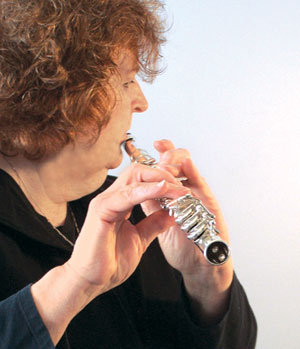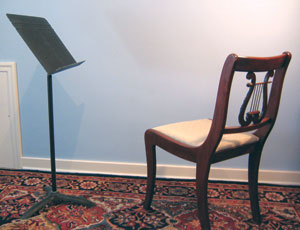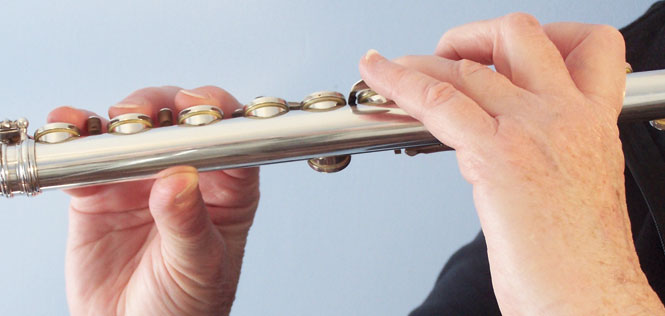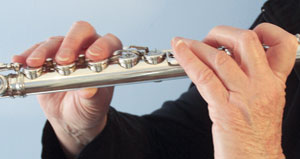Every time I have taught a masterclass series for middle school and high school flutists, I have taken the flute students to another place in the building, while the band director works with the rest of the band in the band room. At some point after a class, the director asks either “What are you teaching” or “What do I need to know.” Share your pedagogical concepts so he can become your ally in teaching the flute students.
Obviously it is impossible to summarize a four-hour masterclass in 10 minutes. I recommend that you make an appointment with the director to clearly explain the concepts and also why they might differ from his woodwind methods class of 20 years ago. If you provided printed handouts for the students, give copies to the band director. (Many of the handouts used in this masterclass series may be downloaded from www.flutetalkmagazine.com under Patricia George’s extras.)
While it is impossible to relate every teaching point that you made with the students, this article features some of the most important ideas that will help the director understand modern flute pedagogy.
No Long Note Playing Games
No band director wants his band to breathe on every bar line. However, beginning flutists usually do so. Musical and artistic breathing involves learning to control the air stream in order to play long phrases. The size of a student and his lungs greatly affects what is possible. Small players are not able to take in the three to five liters of air that many professionals use. Holding notes and long phrases is a challenge for young players, and as teachers we must be prepared to mark where the extra breaths may be taken.
Each instrument in the band requires a different air flow rate. The flute and the tuba have the highest flow rate, while the oboe, with its super small bore, requires the least air flow. If the band director decides to challenge a classroom full of beginners to a long note playing competition, the playing field is not level because of the different air flow requirements of each instrument.
Flutists placed in this situation will do almost anything to win the contest. This encourages them to tense up, close the vocal folds (throat), and squeeze the air out. In other words, they have learned to play with tension and a poor sound quality. Directors should therefore, avoid long note playing games and opt for the excellent exercise below. Not only will it teach student to play naturally on a long air stream, but it will sharpen their counting and concentration skills.
A Solution
The following breathing exercise helps students learn to play long notes in a natural, relaxed fashion and can be used with the entire band on a concert F. This exercises also reinforces individual counting and concentration. With a metronome set on quarter = 60, ask the players to extend their legs straight out in front of them while tapping their feet in the air. Start at a dynamic level of mf, begin on an F quarter note followed by a quarter rest. On each repetition lengthen the quarter note by one beat still followed by a quarter rest. Very quickly young players will be able to play a long note for eight or more counts.
Embouchure Development
No students’ embouchure looks exactly like another’s. Some students have a teardrop in the center of the upper lip, which prevents the aperture (the hole in the lips) from being in the center of the lips. When you have a student with a teardrop, move the aperture to the left rather than the right, which will allow them to bring the right shoulder and end of the flute forward. When the aperture is on the right side, the right shoulder is placed in an uncomfortable position.
To prevent injury after 25 years or so of playing, encourage your students to play with their natural face. Those who make facial contortions in an attempt to look like a picture in a book may eventually develop pain and even be unable to continue playing. Foreheads should be relaxed, and students should play naturally. It is not the face that makes the sound; it is the air.
Marching Band vs. Concert Band
I often tell masterclasses that how we stand and balance the flute in marching band has nothing to do with concert band. It is unfortunate that the rules of marching band performance and competition cannot be changed so that no student has to perform in a way that is detrimental to his concert performance.
 In marching band, flutists stand with both feet together and the flute held parallel to the ground. In concert and solo
In marching band, flutists stand with both feet together and the flute held parallel to the ground. In concert and solo .jpg) performance, flutists stand with the left foot in front at 12:00 o’clock and the right foot back at a 3:00 o’clock. (This is a neutral position from which players can adjust for comfort.) The lower part of the body faces at a 45 degree angle to the right, and the upper body spirals toward the left toes. The end of the flute is not parallel to the shoulders but is slightly forward. The arms should hang from the shoulders, and the left thumb should be straight and pointing to the ceiling. On most average sized thumbs the crease in the left thumb will align at the bottom of the key.
performance, flutists stand with the left foot in front at 12:00 o’clock and the right foot back at a 3:00 o’clock. (This is a neutral position from which players can adjust for comfort.) The lower part of the body faces at a 45 degree angle to the right, and the upper body spirals toward the left toes. The end of the flute is not parallel to the shoulders but is slightly forward. The arms should hang from the shoulders, and the left thumb should be straight and pointing to the ceiling. On most average sized thumbs the crease in the left thumb will align at the bottom of the key.
Chairs and Stands
I have seen so many rehearsal rooms where the chairs and stands are too close together. There should be at least 30 inches between the students’ eyes and the music, so I encourage you to move the chairs back and let the players claim their space. Only oboes, clarinets, and trumpets are played somewhat symmetrically, so those chairs should be the only ones set up with the stand parallel to the back of the chair. All other chairs should be slightly rotated to the right in relationship to the stand. This means that players’ left knees should point toward the stem of the music stand, and the right knee will be pointing to the right.

No flutist should ever have to share a music stand with another player. Provide enough music so that each player has his own stand and music. Band directors of concert bands should experiment with flute section setup to insure good alignment health. I personally prefer a setup based on the woodwind setup of an orchestral section.
The front row might include: Piccolo, Flute I, Oboe I and II, Bassoon I and II. The second row would continue with Flute II and clarinets. Depending on the number of clarinets, the arrangement should place Clarinet I behind the Flute I and Oboe I.
Intonation
Intonation problems will be minimal when the cork placement is correct, the headjoint is pulled out about 1/4", the keys point to the ceiling, and the player uses a good air stream. I find that most school flutists never check their cork placement, think that 1/4" is actually 1/8", play with the keys pointing back to their shoulders, and do not blow well. There is the problem.


(The first picture above shows the keys pointing backward. The second shows them parallel to the ceiling.)
Support
I never use the words support or diaphragm. After hearing these words throughout my public school days, it has taken all the discipline that I can muster to remove them from my vocabulary. When you say the “support” or “support from the diaphragm” to a band, the first thing you see is every child pulling in what they consider to be their tummy, and they continue in that rigid position, page after page.
Breathing is an IN and OUT process. It is not a pulled-in, motionless abdomen. We breathe at the beginning of a phrase and use the air throughout the phrase. At the end of the phrase, we release what is left of the air and then let the air fill the lungs again. The bottom of the lungs is located approximately where the floating ribs are. The top of the lungs are just above the collarbone. Breathing is much higher in the body that most of us think.
The diaphragm is an involuntary muscle, which means that we can not move it at will. It moves down as the lungs fill and up as the lungs empty – a natural process. It is better to talk about the intercostal muscles, which are the muscles located between the ribs. Moving and controlling the intercostals (lifting the ribs) is a great idea.
I think we get better results when we speak about air speed. Most bands sound better immediately when students use faster air at the beginning of a note and think about producing an even air stream throughout the note.
Separate the Vocal Folds
So many teachers ask a student to open their throat. However, when you ask students where there throat is, you receive a vast array of answers. What we want students to understand and do is to separate their vocal folds. To teach this, they need to pant. When panting the vocal folds are separated on both the inhale and the exhale. Learning to play with the vocal folds separated is the goal. You might also have students swallow, because the muscles used to swallow should be relaxed when they play.
Repair or Buy
Many beginners start on a rental flute or on one that a relative has passed down. Recently I had a student proudly tell me that she was the third generation to use her flute, and it had never been to the repair shop! This was the time to expain how important it is to have a flute serviced at least once a year.
A basic yearly service is called a COA or clean, oil, and adjustment. During a COA, the craftsperson cleans the flute of finger prints and tarnish, checks/replaces the cork, checks the fit of the tenons for roundness and seal, removes dents, checks and replaces worn pads, checks felts and corks, adjusts spring tension, and oils the flute. A complete overhaul should be done every 3-5 years, depending on how it is cared for and how much it is played.
In the mid 1980s, most manufactures began producing flutes on a recalibrated scale. Many of the intonation problems on older-scaled flutes were improved. Intonation in a flute section is difficult when some players have old-scaled flutes and others use new-scaled flutes. Instruments produced today all use a modern scale based on the work of Albert Cooper or William Bennett. Because of the new improvements in both the scale and ergonomic design, it is wise to encourage students to purchase a newer flute.
Today there are a group of flutes known as step-up flutes that bridge the gap between the student line and the professional models. I prefer to start beginners on an in-line, open-hole, B-foot flute. At the beginning students use only the headjoint and body, no footjoint, and the holes in the body are plugged and the right hand is placed on the barrel. As students grow, we add the footjoint and eventually remove the plugs. Many flutists prefer flutes with the off-set G rather than the G key in line with the other left-hand keys.
When you set the hands on the flute from the lowest note up (D in the right hand and G# in the left), you discover that the flute fits the student’s hands better than setting the hands on the flute from the top notes (F in the right hand and B in the left), which makes an in line flute as finger friendly as a flute with an offset G.
In line flutes weigh less and feel more streamlined and less clunky in the hand. If a student can afford to upgrade to a silver flute, then choose a silver riser first, then a silver headjoint, a silver body, and finally silver keys.
Most stores allow prospective customers to test two flutes for about 10 days. Players should try out a flute in band, in a large hall or church, at lessons, and at home. The flute should make the player feel creative and be pleasing to play. When choosing a flute, check to be sure that the embouchure hole is no wider than the natural aperture of the player. An embouchure hole that is too large may cause the upper lip to tremble over time.
Thank You
As you conclude the meeting with the band director, thank him for inviting you to work with his students and for all he does for his students and the community. Band directors change the lives of many students each and every day.






